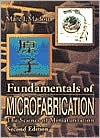Digital Integrated Circuits
Since the publication of the first edition of this book in 1996, CMOS manufacturing technology has continued its breathtaking pace, scaling to ever-smaller dimensions. Minimum feature sizes are now reaching the 100-rim realm. Circuits are becoming more complex, challenging the productivity of the designer, while the plunge into the deep-submicron space causes devices to behave differently and brings to the forefront a number of new issues that impact the reliability, cost, performance, power...
Search in google:
Progressive in content and form, this practical book successfully bridges the gap between the circuit perspective and system perspective of digital integrated circuit design. Digital Integrated Circuits maintains a consistent, logical flow of subject matter throughout.Addresses today's most significant and compelling industry topics, including: the impact of interconnect, design for low power, issues in timing and clocking, design methodologies, and the tremendous effect of design automation on the digital design perspective.For readers interested in digital circuit design.
What is New?\ Welcome to second edition of "Digital Integrated Circuits: A Design Perspective." In the six years since the publication of the first, the field of digital integrated circuits has gone through some dramatic evolutions and changes. IC manufacturing technology has continued to scale to ever-smaller dimensions. Minimum feature sizes have scaled by a factor of almost ten since the writing of the first edition, and now are approaching the 100 nm realm. This scaling has a double impact on the design of digital integrated circuit. First of all, the complexity of the designs that can be put on a single die has increased dramatically. Dealing with the challenges this poses has led to new design methodologies and implementation strategies. At the same time, the plunge into the deep-submicron space causes devices to behave differently, and brings to the forefront a number of new issues that impact the reliability, cost, performance, and power dissipation of the digital IC. Addressing these issues in-depth is what differentiates this edition from the first.\ A glance through the table of contents reveals extended coverage of issues such as deep-sub micron devices, circuit optimization, interconnect modeling and optimization, signal integrity, clocking and timing, and power dissipation. All these topics are illustrated with state-of-the-art design examples. Also, since MOS now represents more than 99% of the digital IC market, older technologies such as silicon bipolar and GaAs have been deleted (however, the interested reader can find the old chapters on these technologies on the web site of the book). Given the importance of methodology in today's design process, we have included Design Methodology Inserts throughout the text, each of which highlights one particular aspect of the design process. This new edition represents a major reworking of the book. The biggest change is the addition of two co-authors, Anantha and Bora, who have brought a broader insight into digital IC design and its latest trends and challenges.\ Maintaining the Spirit of the First Edition\ While introducing these changes, our intent has been to preserve the spirit and goals of the first edition—that is, to bridge the gap between the circuit and system visions on digital design. While starting from a solid understanding of the operation of electronic devices and an in-depth analysis of the nucleus of digital design—the inverter—we gradually channel this knowledge into the design of more complex modules such as gates, registers, controllers, adders, multipliers, and memories. We identify the compelling questions facing the designers of today's complex circuits: What are the dominant design parameters, what section of the design should he focus on and what details could she ignore? Simplification is clearly the only approach to address the increasing complexity of the digital systems. However, oversimplification can lead to circuit failure since global circuit effects such as timing, interconnect, and power consumption are ignored. To avoid this pitfall it is important to design digital circuits with both a circuits and a systems perspective in mind. This is the approach taken in this book, which brings the reader the knowledge and expertise needed to deal with complexity, using both analytical and experimental techniques.\ How to Use This Book\ The core of the text is intended for use in a senior-level digital circuit design class. Around this kernel, we have included chapters and sections covering the more advanced topics. In the course of developing this book, it quickly became obvious that it is difficult to define a subset of the digital circuit design domain that covers everyone's needs. On the one hand, a newcomer to the field needs detailed coverage of the basic concepts. On the other hand, feedback from early readers and reviewers indicated that an in-depth and extensive coverage of advanced topics and current issues is desirable and necessary. Providing this complete vision resulted in a text that exceeds the scope of a single-semester class. The more advanced material can be used as the basis for a graduate class. The wide coverage and the inclusion of state-of-the-art topics also makes the text useful as a reference work for professional engineers. It is assumed that students taking this course are familiar with the basics of logic design.\ The organization of the material is such that the chapters can be taught or read in many ways, as long as a number of precedence relations are adhered to. The core of the text consists of Chapters 5, 6, 7, and 8. Chapters 1 to 4 can be considered as introductory. In response to popular demand, we have introduced a short treatise on semiconductor manufacturing in Chapter 2. Students with 4 prior introduction to semiconductor devices can traverse quickly .through Chapter 3. We urge everyone to do at least that, as a number of important notations and foundations are introduced in that chapter. In addition, an original approach to the modeling of deep-submicron transistors enabling manual analysis, is introduced. To emphasize the importance of interconnect in today's digital design, we have moved the modeling of interconnect forward in the text to Chapter 4.\ Chapters 9 to 12 are of a more advanced nature and can be used to provide a certain focus to the course. A course with a focus on the circuit aspects, for example, can supplement the core material with Chapters 9 and 12. A course focused on the digital system design should consider adding (parts of) Chapters 9, 10, and 11. All of these advanced chapters can be used to form the core of a graduate or a follow-on course. Sections considered advanced are marked with an asterisk in the text.\ A number of possible paths through the material for a senior-level class are enumerated below. In the instructor documentation, provided on the book's web site, we have included a number of complete syllabi based on courses run at some academic institutions.\ Basic circuit class (with minor prior device knowledge):\ 1, 2.1-3, 3, 4, 5, 6, 7, 8, (9.1-9.3, 12).\ Somewhat more advanced circuit coverage:\ 1, (2, 3), 4, 5, 6, 7, 8, 9, 10.1-10.3, 10.5-10.6, 12.\ Course with systems focus:\ 1, (2, 3), 4, 5, 6, 7, 8, 9, 10.1-10.4, 11, 12.1-12.2.\ The design methodology inserts are, by preference, covered in concurrence with the chapter to which they are attached.\ In order to maintain a consistent flow through each of the chapters, the topics are introduced first, followed by a detailed and in-depth discussion of the ideas. A Perspective section discusses how the introduced concepts relate to real world designs and how they might be impacted by future evolutions. Each chapter finishes with a Summary, which briefly enumerates the topics covered in the text, followed by To Probe Further and Reference sections. These provide ample references and pointers for a reader interested in further details on some of the material.\ As the title of the book implies, one of the goals of this book is to stress the design aspect of digital circuits. To achieve this more practical viewpoint and to provide a real perspective, we have interspersed actual design examples and layouts throughout the text. These case studies help to answer questions, such as "How much area or speed or power is really saved by applying this technique?" To mimic the real design process, we are making extensive use of design tools such as circuit- and switch-level simulation as well as layout editing and extraction. Computer analysis is used throughout to verify manual results, to illustrate new concepts, or to examine complex behavior beyond the reach of manual analysis.\ Finally, to facilitate the learning process, there are numerous examples included in the text. Each chapter contains a number of problems or brain-teasers (answers for which can be found in the back of the book), that provoke thinking and understanding while reading.\ The Worldwide Web Companion\ A worldwide web companion (http://bwrc.eecs.berkeley.edu/IcBook/index.htm) provides fully worked-out design problems and a complete set of overhead transparencies, extracting the most important figures and graphs from the text.\ In contrast to the first edition, we have chosen NOT to include problems sets and design problems in the text. Instead we decided to make them available on the book's web site. This gives us the opportunity to dynamically upgrade and extend the problems, providing a more effective tool for the instructor. More than 300 challenging exercises are currently provided. The goal is to provide the individual reader an independent gauge for his understanding of the material and to provide practice in the use of some of the design tools. Each problem is keyed to the text sections it refers to (e.g., <1.3>), the design tools that must be used when solving the problem (e.g., SPICE) and a rating, ranking the problems on difficulty: (E) easy, (M) moderate, and (C) challenging. Problems marked with a (D) include a design or research elements. Solutions to the problem sets are available only to instructors of academic institutions that have chosen to adopt our book for classroom use. They are available through the publisher on a password-protected web site.\ Open-ended design problems help to gain the all-important insight into design optimization and trade-off. The use of design editing, verification and analysis tools is recommended when attempting these design problems. Fully worked out versions of these problems can be found on the web site.\ In addition, the book's web site also offers samples of hardware and software laboratories, extra background information, and useful links.\ Compelling Features of the Book\ \ Brings both circuit and systems views on design together. It offers a profound understanding of the design of complex digital circuits, while preparing the designer for new challenges that might be waiting around the corner.\ Design-oriented perspectives are advocated throughout. Design challenges and guidelines are highlighted. Techniques introduced in the text are illustrated with real designs and complete SPICE analysis.\ Is the first circuit design book that focuses solely on deep-submicron devices. To facilitate this, a simple transistor model for manual analysis, called the unified MOS model, has been developed.\ Unique in showing how to use the latest techniques to design complex high-performance or low-power circuits. Speed and power treated as equal citizens throughout the text.\ Covers crucial real-world system design issues such as signal integrity, power dissipation, interconnect, packaging, timing, and synchronization.\ Provides unique coverage of the latest design methodologies and tools, with a discussion of how to use them from a designers' perspective.\ Offers perspectives on how digital circuit technology might evolve in the future.\ Outstanding illustrations and a usable design-oriented four-color insert.\ To Probe Further and Reference sections provide ample references and pointers for a reader interested in further details on some of the material.\ Extensive instructional package is available over the internet from the author's web site.\ Includes design software, transparency masters, problem sets, design problems, actual layouts, and hardware and software laboratories.\ \ The Contents at a Glance\ A quick scan of the table of contents shows how the ordering of chapters and the material covered are consistent with the advocated design methodology. Starting from a model of the semiconductor devices, we will gradually progress upwards, covering the inverter, the complex logic gate (NAND, NOR, XOR), the functional (adder, multiplier, shifter, register) and the system module (datapath, controller, memory) levels of abstraction. For each of these layers, the dominant design parameters are identified and simplified models are constructed, abstracting away the nonessential details. While this layered modeling approach is the designer's best handle on complexity, it has some pitfalls. This is illustrated in Chapters 9 and 10, where topics with a global impact, such as interconnect parasitics and chip timing, are discussed. To further express the dichotomy between circuit and system design visions, we have divided the book contents into two major parts: Part II (Chapters 4-7) addresses mostly the circuit perspective of digital circuit design, while Part III (Chapters 8-12) presents a more system oriented vision. Part I (Chapters 1-4) provides the necessary foundation (design metrics, the manufacturing process, device and interconnect models).\ Chapter 1 serves as a global introduction. After a historical overview of digital circuit design, the concepts of hierarchical design and the different abstraction layers are introduced. A number of fundamental metrics, which help to quantify cost, reliability, and performance of a design, are introduced.\ Chapter 2 provides a short and compact introduction to the MOS manufacturing process. Understanding the basic steps in the process helps to create the three-dimensional understanding of the MOS transistor, which is crucial when identifying the sources of the device parasitics. Many of the variations in device parameters can also be attributed to the manufacturing process as well. The chapter further introduces the concept of design rules, which form the interface between the designer and the manufacturer. The chapter concludes with an overview of the chip packaging process, an often-overlooked but crucial element of the digital IC design cycle.\ Chapter 3 contains a summary of the primary design building blocks, the semiconductor devices. The main goal of this chapter is to provide an intuitive understanding of the operation of the MOS as well as to introduce the device models, which are used extensively in the later chapters. Major attention is paid to the artifacts of modern submicron devices, and the modeling thereof. Readers with prior device knowledge can traverse this material rather quickly.\ Chapter 4 contains a careful analysis of the wire, with interconnect and its accompanying parasitics playing a major role. We visit each of the parasitics that come with a wire (capacitance, resistance, and inductance) in turn. Models for both manual and computer analysis are introduced.\ Chapter 5 deals with the nucleus of digital design, the inverter. First, a number of fundamental properties of digital gates are introduced. These parameters, which help to quantify the performance and reliability of a gate, are derived in detail for two representative inverter structures: the static complementary CMOS. The techniques and approaches introduced in this chapter are of crucial importance, as they are repeated over and over again in the analysis of other gate structures and more complex gate structures.\ In Chapter 6 this fundamental knowledge is extended to address the design of simple and complex digital CMOS gates, such as NOR and NAND structures. It is demonstrated that, depending upon the dominant design constraint (reliability, area, performance, or power), other CMOS gate structures besides the complementary static gate can be attractive. The properties of a number of contemporary gate-logic families are analyzed and compared. Techniques to optimize the performance and power consumption of complex gates are introduced.\ Chapter 7 discusses how memory function can be accomplished using either positive feedback or charge storage. Besides analyzing the traditional bistable flip-flops, other sequential circuits such as the mono- and astable multivibrators are also introduced. All chapters prior to Chapter 7 deal exclusively with combinational circuits, that is circuits without a sense of the past history of the system. Sequential logic circuits, in contrast, can remember and store the past state.\ All chapters preceding Chapter 8 present a circuit-oriented approach towards digital design. The analysis and optimization process has been constrained to the individual gate. In this chapter, we take our approach one step further and analyze how gates can be connected together to form the building blocks of a system. The system-level part of the book starts, appropriately, with a discussion of design methodologies. Design automation is the only way to cope with the ever-increasing complexity of digital designs. In Chapter 8, the prominent ways of producing large designs in a limited time are discussed. The chapter spends considerable time on the different implementation methodologies available to today's designer. Custom versus semi-custom, hardwired versus fixed, regular array versus ad-hoc are some of the issues put forward.\ Chapter 9 revisits the impact of interconnect wiring on the functionality and performance of a digital gate. A wire introduces parasitic capacitive, resistive, and inductive effects, which are becoming ever more important with the scaling of the technology. Approaches to minimize the impact of these interconnect parasitics on performance, power dissipation and circuit reliability are introduced. The chapter also addresses some important issues such as supply-voltage distribution, and input/output circuitry.\ In Chapter 10 details how that in order to operate sequential circuits correctly, a strict ordering of the switching events has to be imposed. Without these timing constraints, wrong data might be written into the memory cells. Most digital circuits use a synchronous, clocked approach to impose this ordering. In Chapter 10, the different approaches to digital circuit timing and clocking are discussed. The impact of important effects such as clock skew on the behavior of digital synchronous circuits is analyzed. The synchronous approach is contrasted with alternative techniques, such as self-timed circuits. The chapter concludes with a short introduction to synchronization and clock-generation circuits.\ In Chapter 11, the design of a variety of complex arithmetic building blocks such as adders, multipliers, and shifters, is discussed. This chapter is crucial because it demonstrates how the design techniques introduced in chapters 5 and 6 are extended to the next abstraction layer. The concept of the critical path is introduced and used extensively in the performance analysis and optimization. Higher-level performance models are derived. These help the designer to get a fundamental insight-into the operation and quality of a design module, without having to resort to an in-depth and detailed analysis of the underlying circuitry.\ Chapter 12 discusses in depth the different memory classes and their implementation. Whenever large amounts of data storage are needed, the digital designer resorts to special circuit modules, called memories. Semiconductor memories achieve very high storage density by compromising on some of the fundamental properties of digital gates. Instrumental in the design of reliable and fast memories is the implementation of the peripheral circuitry, such as the decoders, sense amplifiers, drivers, and control circuitry, which are extensively covered. Finally, as the primary issue in memory design is to ensure that the device works consistently under all operating circumstances, the chapter concludes with a detailed discussion of memory reliability. This chapter as well as the previous one are optional for undergraduate courses.
PrefacePt. 1The Fabrics1Ch. 1Introduction3Ch. 2The Manufacturing Process35Design Methodology Insert A: IC LAYOUT67Ch. 3The Devices73Design Methodology Insert B: Circuit Simulation131Ch. 4The Wire135Pt. 2A Circuit Perspective177Ch. 5The CMOS Inverter179Ch. 6Designing Combinational Logic Gates in CMOS235Design Methodology Insert C: How to Simulate Complex Logic Circuits309Design Methodology Insert D: Layout Techniques for Complex Gates319Ch. 7Designing Sequential Logic Circuits325Pt. 3A System Perspective375Ch. 8Implementation Strategies for Digital ICS377Design Methodology Insert E: Characterizing Logic and Sequential Cells427Design Methodology Insert F: Design Synthesis435Ch. 9Coping with Interconnect445Ch. 10Timing Issues in Digital Circuits491Design Methodology Insert G: Design Verification553Ch. 11Designing Arithmetic Building Blocks559Ch. 12Designing Memory and Array Structures623Design Methodology Insert H: Validation and Test of Manufactured Circuits721Problem Solutions739Index745
\ From Barnes & NobleThe Barnes & Noble Review\ Designing integrated circuits was never easy, and with the recent explosion of technology into the deep-submicron realm, things have become even more challenging. Jan M. Rabaey, Anantha Chandrakasan, and Borivoje Nikolic have done an excellent job of writing a senior-level digital circuit design class refresher book for people who have been working at designing digital integrated circuits. And, for those of you who are somewhere in the learning curve, this book is a must-have. It makes available the most up-to-date design methodology and tools for Complementary Metallic Oxide Semiconductor-Integrated Circuits (CMOS-ICs). \ This outstanding second edition has been completely revamped to deal only with CMOS-ICs. The book has a companion web site that complements the work, including updates and corrections to the material covered within it. In addition, the availability of up-to-date problem sets and exercises (which are readily available only on the web site) is a terrific feature. By making the exercises available electronically rather than in print, the authors provide a dynamic environment that tracks the rapid evolution of today's digital integrated circuit design technology.\ Trying to keep up with technology that evolves at this pace requires constant vigilance. This book captures the latest design issues and insights that will make it easier for the avid reader and student to keep up. John Vacca\ John Vacca, the former computer security official (CSO) for NASA's space station program (Freedom), has written 38 books about advanced storage, computer security, and aerospace technology.\ \ \








